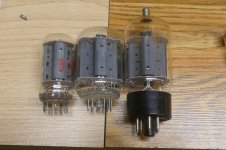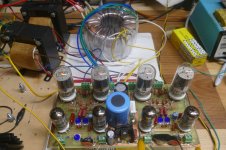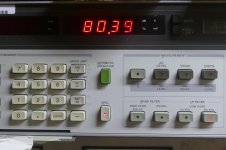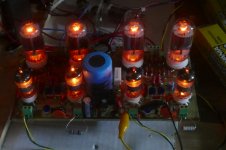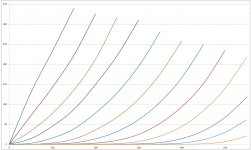Good Tuesday everyone,
Here is what I have to work with:
1) B+ of 450 vdc.
2) Screen voltage as needed.
3) 100 watt output transformer, 4K P-P to 4, 8, & 16 ohm.
4) Tubes that I have WAY too many of: 7984, 8950, M-2057, 8236, 6LB6, & 21LG6a
Any thoughts on what tube to use with what I have???
Thanks
Ray
Here is what I have to work with:
1) B+ of 450 vdc.
2) Screen voltage as needed.
3) 100 watt output transformer, 4K P-P to 4, 8, & 16 ohm.
4) Tubes that I have WAY too many of: 7984, 8950, M-2057, 8236, 6LB6, & 21LG6a
Any thoughts on what tube to use with what I have???
Thanks
Ray
Attachments
You will need to get the data sheets, make the loadline with the voltage supply available and the output load resistance, and if no one gives the power you need, then start paralleling them. It seems toi me that no less than 3 per trafo side, in parallel oushpull.
The simple dumm blonde formula for max power in a push pull amp is )(B+ voltage * 1.42) squared) / OPT impedance. This assumes some magical output tubes that can put all of the power supply into the OPT, which is lossless. In this case the best possible outcome is 102 watts......reality is 85 to 90 watts with one pair of fat sweep tubes, and two pair of wimpy ones.
The M2057 is the fattest of the tubes you list, and I have seen 160 real measured watts flow from one pair of 6LW6's (like a M2057) into an Edcor 3300 ohm OPT on 550 volts. Tube dissipation spec will be exceeded if you try to run continuous sine waves at 2/3rds of max power or higher for long time periods. There is no problem playing music at the threshold of clipping forever.
Any of the tubes you list will work except the 7984 it is a RF amp tube. The 8950 is a 12 volt sweep tube intended for RF amp use. It is rare and expensive. Sell them to someone who has an old Siltronix radio that needs them for $$$$.
All true sweep tubes like 150 to 175 volts on G2 in audio output service. Either set it at 150 volts and forget it, or tune for maximum measured plate efficiency, which will be close to 150 volts.
The M2057 is the fattest of the tubes you list, and I have seen 160 real measured watts flow from one pair of 6LW6's (like a M2057) into an Edcor 3300 ohm OPT on 550 volts. Tube dissipation spec will be exceeded if you try to run continuous sine waves at 2/3rds of max power or higher for long time periods. There is no problem playing music at the threshold of clipping forever.
Any of the tubes you list will work except the 7984 it is a RF amp tube. The 8950 is a 12 volt sweep tube intended for RF amp use. It is rare and expensive. Sell them to someone who has an old Siltronix radio that needs them for $$$$.
All true sweep tubes like 150 to 175 volts on G2 in audio output service. Either set it at 150 volts and forget it, or tune for maximum measured plate efficiency, which will be close to 150 volts.
Last edited:
Yes.
First check which ones stand the voltage, then how many in parallel you ned to stand or eceed power dissipation; same with current, in principle I consider Tubes as "current limited devices".
As an extra detail, which ones are happy with about 400V screens.
If not, you may have to down regulate screen voltage, probably with a suitable MosFet.
I had to do that with 6DQ6 whose plates stand *a lot*, but whose screens are really safe with 150V or so.
First check which ones stand the voltage, then how many in parallel you ned to stand or eceed power dissipation; same with current, in principle I consider Tubes as "current limited devices".
As an extra detail, which ones are happy with about 400V screens.
If not, you may have to down regulate screen voltage, probably with a suitable MosFet.
I had to do that with 6DQ6 whose plates stand *a lot*, but whose screens are really safe with 150V or so.
First check which ones stand the voltage
All except the 7984 are TV sweep tubes, or TV sweep tubes modified for RF or other service. All will stand kilovolt+ levels on the plate, none will stand 400 volts on G2 for long. All have peak current capabilities over 1 amp. 1.1 amps for the 6LB6 and 6LG6, and 1.4 amps for the M2057 and 8950. No peak cathode current specified for the 8236. I have never seen one of these, so I can't say for sure how well they work for audio, but I have seen over 100 watts flow from the other 4 for extended periods of time.
I had 250 watts flow from one pair of the similar 6LR6 into 2500 ohms on 650 volts, and 525 watts from two pair into 1250 ohms on 650 volts. A dul red glow began to show after about 5 minutes of continuous sine wave operation at these power levels.....any of these 4 tubes, and probably the 8236 as well should be quite happy at nearly 100 watts into 4000 ohms.
I'm thinking 7984 is the compactron version of the 12 volt 6146B.
I have some here somewhere. They are nothing like a 6146 inside since they are designed for VHF radios. All the guts are smaller. They have two short "U" shaped plates like those seen in a 6AS7 or 6080, and they don't like my abuse, so they got stuck in a box somewhere out of the way. I think they might be good for a 50 WPC or so audio amp, but I can get 50 watts from any of several cheap tubes, so why bother with weird stuff.
" ... The popular 6146 transmitting tube has been compactronized in such fashion that it delivers ... It bears the EIA designation of type 7984 ..."
See, Four New Small G-E Transmitting Tubes Announced, GE Ham News, November-December 1962.
edit: my copy is too big to upload, so I pulled the issue apart, and uploaded the pertinent article.
The whole issue is compactron oriented.
See, Four New Small G-E Transmitting Tubes Announced, GE Ham News, November-December 1962.
edit: my copy is too big to upload, so I pulled the issue apart, and uploaded the pertinent article.
The whole issue is compactron oriented.
Attachments
Last edited:
100W is barely achievable with theoretically perfect and lossless components with B+ of 450V on a 4K transformer. 80W is more of a realistic expectation if you do a good job of optimizing for power output.
If you need 100W, you will have increase B+ to get it.
If you need 100W, you will have increase B+ to get it.
6146 transmitting tube has been compactronized in such fashion that it delivers ... It bears the EIA designation of type 7984
Hey, I'm old and it's possible that I am remembering the number incorrectly, but I have a bag full of some smallish compactron RF tubes which I can't find now that did not fare well in the Tubelab crank em up test. Either way, the OP has several likely candidates for a 100 watt amp that would stomp a true 6146, which CAN barely squeeze out 100 watts, but with less margin than any of the 4 mentioned sweep tubes.
.If you need 100W, you will have increase B+ to get it
Or use a 3300 ohm OPT
6146B lists 175 mA max DC
7984 lists 150 mA max DC
6146B lists 260 deg C max glass temp
7984 lists 220 deg C max glass temp (so may need forced air cooling)
Both tubes list Pdiss as absolute max, design max would be more like .7x that. (20 Watts)
The little 17.5 Watt Pdiss 6GE5/6JN6 TV Sweep has got a similar sized plate.
A pair of 17/22KV6 or 6HJ5 NO-cap TV tubes could likely do 75 Watt output easily.
8236 is a 6DQ5 with a graphite plate.
8950 is a re-based 6LX6
M2057 is a re-based 6LW6
7984 lists 150 mA max DC
6146B lists 260 deg C max glass temp
7984 lists 220 deg C max glass temp (so may need forced air cooling)
Both tubes list Pdiss as absolute max, design max would be more like .7x that. (20 Watts)
The little 17.5 Watt Pdiss 6GE5/6JN6 TV Sweep has got a similar sized plate.
A pair of 17/22KV6 or 6HJ5 NO-cap TV tubes could likely do 75 Watt output easily.
8236 is a 6DQ5 with a graphite plate.
8950 is a re-based 6LX6
M2057 is a re-based 6LW6
Last edited:
Or use a 3300 ohm OPT
Yep, get new power transformer, get new output transformers, or accept ~80W. Pick your poison.
Yep, get new power transformer, get new output transformers, or accept ~80W. Pick your poison.
And remember …
dB = 10log₁₀(100 ÷ 80)
dB = +0.97 dB
dB = +0.97 dB
So, at the loudest sustainable output, the 100 watt amp is only 1 dB louder than the 80 watt model. Now if in a deafeningly loud listening room, one can materially tell the difference (let alone find real worrisome dissatisfaction) between 110 dB and 111 dB …
Build the monster, using the power transformer and output transformers you have. Be satisfied with a really dynamic 75 W average top power. Use decent components, great wiring practices, star grounding. Keep your cool, and invest in curious-fingers-don't-belong-there grilles and the like.
Just saying,
GoatGuy ✓
Already having a 4K OT, one can take advantage of low screen current tubes (and hence low screen current distortion) at the higher Zpri (versus 3.3K) for low distortion power output.
Low screen current tubes on the list would include 21LG6A, 6LB6, 8950/6LX6, M2057/6LW6, 7984
17/22KV6 is low screen current too, No-cap, recommend considering.
Avoid 8236/6DQ5 medium screen current
6HJ5 is very close to the 6DQ5, fine for a 3.3K OT for more power
Low screen current tubes on the list would include 21LG6A, 6LB6, 8950/6LX6, M2057/6LW6, 7984
17/22KV6 is low screen current too, No-cap, recommend considering.
Avoid 8236/6DQ5 medium screen current
6HJ5 is very close to the 6DQ5, fine for a 3.3K OT for more power
Last edited:
Too bad they don't sell 300B at Ham swap meets. By low screen current/low screen distortion tubes, I meant having plate curves that are reasonably straight lines above the knees. I just noticed that 7984 has rather curved plate curves, so remove that one from the list for the 4K OT.
Yes, 8950's are going for stupid money since the CB and ham radio amps of the 80's ate up most of the world's supply. Remember the Siltronix 1011? It was essentially a 100 watt CB radio......don't cut the yellow jumper in the USA. It used an 8950 for the RF final output.
If it was my choice and I already had the OPT's I would as you say, just build it and take what it gives me.
I have a DIY push pull amp with some of the tiniest sweep tubes ever made, the 6GF5. A pair of them can be squeezed to 80 watts without the red glow of death. My amp will make 80 watts per channel when run from a regulated 525 volt supply with a 6600 ohm OPT.
It makes 50+ WPC when fed with a cheap Antek toroid power transformer. The 525 volt B+ drops to around 450 when both channels are driven to full power continuously. Put a big fat cap in the power supply and call it a 50 WPC amp with 75 watts of dynamic headroom for transients.
Note that the 6GF5 and larger 6GE5 are actually 6DQ6's stuffed into compactron bottles. The 6GF5's have the wings clipped off the plates to fit in the skinny glass.
The first picture shows the 6GF5 on the left, the 6GE5 in the center, and the 6DQ6 on the right. All have been confirmed to operate the same in the prototype design.
The second picture shows the amp running from an Antek toroid.
The third picture shows the power output at 80 watts when running on my Fluke 407D at 525 volts.....I didn't want to push the 500 volt caps on the board any further. That fat blue one in the center is wired across the B+ and could get real ugly if it blows up.
The fourth picture shows the THD at 80 watts, roughly 3%.
The fifth picture shows the tubes in the dark after several minutes of operating at 80 WPC. There is a slight hint of red in one tube.
If these little guys can crank out 80 watts per pair continuously without issue, then any of those big sweep tubes can do the same.....forever.
Note that this amp uses a new technique that I'm not quite ready to divulge yet. The sweep tubes run in triode mode, but their screen grids are happy at 150 volts......the 6th picture shows the curves I hand traced from a 6GF5. The slight error in the dark green trace is due to a bad pot in in the old power supply. The plate efficiency is about the same as conventional pentode mode though.
If it was my choice and I already had the OPT's I would as you say, just build it and take what it gives me.
I have a DIY push pull amp with some of the tiniest sweep tubes ever made, the 6GF5. A pair of them can be squeezed to 80 watts without the red glow of death. My amp will make 80 watts per channel when run from a regulated 525 volt supply with a 6600 ohm OPT.
It makes 50+ WPC when fed with a cheap Antek toroid power transformer. The 525 volt B+ drops to around 450 when both channels are driven to full power continuously. Put a big fat cap in the power supply and call it a 50 WPC amp with 75 watts of dynamic headroom for transients.
Note that the 6GF5 and larger 6GE5 are actually 6DQ6's stuffed into compactron bottles. The 6GF5's have the wings clipped off the plates to fit in the skinny glass.
The first picture shows the 6GF5 on the left, the 6GE5 in the center, and the 6DQ6 on the right. All have been confirmed to operate the same in the prototype design.
The second picture shows the amp running from an Antek toroid.
The third picture shows the power output at 80 watts when running on my Fluke 407D at 525 volts.....I didn't want to push the 500 volt caps on the board any further. That fat blue one in the center is wired across the B+ and could get real ugly if it blows up.
The fourth picture shows the THD at 80 watts, roughly 3%.
The fifth picture shows the tubes in the dark after several minutes of operating at 80 WPC. There is a slight hint of red in one tube.
If these little guys can crank out 80 watts per pair continuously without issue, then any of those big sweep tubes can do the same.....forever.
Note that this amp uses a new technique that I'm not quite ready to divulge yet. The sweep tubes run in triode mode, but their screen grids are happy at 150 volts......the 6th picture shows the curves I hand traced from a 6GF5. The slight error in the dark green trace is due to a bad pot in in the old power supply. The plate efficiency is about the same as conventional pentode mode though.
Attachments
Looks like all $1 tubes in that 80 Watt amplifier!
Another good $1 output tube is the 38HE7 (running just the pentode, 21V Htr at pins 10 and 12, close to a 21HB5 with trimmed down plate fins, and = 1/2 of an old style 42KN6) (about 80% of the 38HE7 tubes I've checked have the optional Htr tap on pin10)
Rsumperl: On those 7054/8077 driver tubes; take a look at 6197 (a 6CL6 derivative) too, I have found them to be remarkably linear on the curve tracer. But any of these tubes will perform excellently in a differential stage, as in that schematic. I was able to get some new GE 6197 tubes on Ebay earlier this year for well under $1.
Another good $1 output tube is the 38HE7 (running just the pentode, 21V Htr at pins 10 and 12, close to a 21HB5 with trimmed down plate fins, and = 1/2 of an old style 42KN6) (about 80% of the 38HE7 tubes I've checked have the optional Htr tap on pin10)
Rsumperl: On those 7054/8077 driver tubes; take a look at 6197 (a 6CL6 derivative) too, I have found them to be remarkably linear on the curve tracer. But any of these tubes will perform excellently in a differential stage, as in that schematic. I was able to get some new GE 6197 tubes on Ebay earlier this year for well under $1.
Last edited:
Looks like all $1 tubes in that 80 Watt amplifier!
Yes. $8 worth of tubes all in emulated triode mode.
I have an SE version with which I have squeezed 40 WPC out of 36LW6's, but they were a bit red faced at that power level. It makes a good 20 watts out of some 25DN6's that I paid 50 cents each for. I call it UNSET, since it performs like a SET, but has no triodes in it at all. That one runs all of $3 worth of tubes.
So, 6JC6 tubes too I presume, $1 list.
Besides the early $1 list ones I got years back, I got some cheesy looking Westinghouse (Japan) 6JC6s from Vacuumtubes.net quantity discount sales a year or two ago, and I was surprised to find that they have -Par-Excellent- "triode" mode curves. No special circuit needed for them. Their pentode curves weren't so good, bad knees, but the triode mode curves were way better than the USA made ones. The USA ones have good pentode curves though.
Go figure..
I have found that some of the high gm RF TV front end tubes (and IF ones too) have bad pentode knees (high knee V, or even hysteresis effects in the direction of the knee scan on the curve tracer ). I think they intentionally reduced the window in the g3/beam plate (below optimum for beaming, effectively repelling some of the beam back to g2 at low plate V) to reduce capacitance from plate back to grid 1. If the g3 is brought out to a separate pin, one can apply some modest +V to g3 to fix the knee problems (like +12V to +24V). The Westinghouse (Japan) 6JC6 will fix up for pentode mode this way. Another messed up tube is 5/6JK6, and it fixes up this way too.
The Marantz 10B puts -V on g3 for the 6JK6 tubes in it for some curious reason (simplified bias maybe). I have tested 5/6JK6 with -V on g3 on the curve tracer and the curves just get worse!!! Horrible knee hysteresis.
Besides the early $1 list ones I got years back, I got some cheesy looking Westinghouse (Japan) 6JC6s from Vacuumtubes.net quantity discount sales a year or two ago, and I was surprised to find that they have -Par-Excellent- "triode" mode curves. No special circuit needed for them. Their pentode curves weren't so good, bad knees, but the triode mode curves were way better than the USA made ones. The USA ones have good pentode curves though.
Go figure..
I have found that some of the high gm RF TV front end tubes (and IF ones too) have bad pentode knees (high knee V, or even hysteresis effects in the direction of the knee scan on the curve tracer ). I think they intentionally reduced the window in the g3/beam plate (below optimum for beaming, effectively repelling some of the beam back to g2 at low plate V) to reduce capacitance from plate back to grid 1. If the g3 is brought out to a separate pin, one can apply some modest +V to g3 to fix the knee problems (like +12V to +24V). The Westinghouse (Japan) 6JC6 will fix up for pentode mode this way. Another messed up tube is 5/6JK6, and it fixes up this way too.
The Marantz 10B puts -V on g3 for the 6JK6 tubes in it for some curious reason (simplified bias maybe). I have tested 5/6JK6 with -V on g3 on the curve tracer and the curves just get worse!!! Horrible knee hysteresis.
Last edited:
So, 6JC6 tubes too I presume, $1 list
I have tried all the pin compatible tubes that I have in this design. This goes for the $1 tubes all the way up to the 12BY7, all work with the right resistor value tweaking. The positive voltage on G3 trick works wonders on some tubes, especially semi remote cutoff types like the 6EH7. I don't remember which $1 tube was in the amp when I took those pictures, probably the 6KT6 because I have a lot of them, and about half are Japanese.
On a slightly different note, take a 6BE6 pentagrid converter tube and tie ALL the grids together, then plug it into your curve tracer......at least the two old tubes that I have make pretty triode curves.
Last edited:
- Home
- Amplifiers
- Tubes / Valves
- Possibility of 100 Watts?
